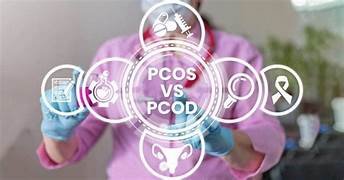Decoding PCOS and PCOD: Recognizing the Variances

Millions of women worldwide are affected by the prevalent hormonal conditions known as polycystic ovarian syndrome (PCOS) and polycystic ovarian disorder (PCOD). These are different ailments with different symptoms, causes, and treatments even though their names are identical. Correct diagnosis and successful treatment of PCOS depend on an understanding of the distinctions between the two conditions.
We will discuss in great detail about both disorders in this blog, so you know what you need to know.
PCOS and PCOD: Differentiating the Terms
Let me first define some terms before going any further. For Polycystic Ovary Syndrome, see PCOS. The titles, though they could be used interchangeably, stand for distinct facets of the illnesses.
A syndrome, as PCOS is, is a group of connected and coexisting symptoms. Conversely, PCOD designates a condition that denotes an anomaly in structure or function. Knowing this little difference facilitates understanding the fundamental complexity of these situations.
Understanding PCOS
Multiple little cysts on the ovaries, irregular menstruation periods, and high androgen levels are just a few of the signs of the hormonal condition known as polycystic ovary syndrome (PCOS). Often called cysts because of how they seem on ultrasound, these are actually immature follicles.
Although its precise cause is yet unknown, environmental and genetic elements are thought to be involved. Its emergence is mostly influenced by hormonal imbalances and insulin resistance, especially high androgen (male hormone) levels.
Symptoms of PCOS
- Irregular or non-existent menstruation.
- Excessive hair growth on the face, chest, or back (hirsutism).
- Oily and acne-prone skin.
- Weight increase or problems dropping weight.
- Scalp hair thinning or loss.
- Skin darkening (acanthosis nigricans), especially in folds like the neck or beneath the breasts.
Additionally PCOS is linked to a higher risk of type 2 diabetes, high blood pressure, infertility, and cardiovascular disease are PCOS-related health issues. Minimizing these risks and enhancing general health outcomes need early identification and treatment.
Understanding PCOD
Multiple cysts on the ovaries are the main feature of polycystic ovarian disorder (PCOD), sometimes referred to as polycystic ovarian morphology (PCOM). Contrary to PCOS, which can not always manifest with the same set of symptoms, some women with PCOD may have regular menstrual cycles and no evidence of androgen excess.
Many times, PCOD is identified by ultrasound imaging, which shows the ovaries to have several tiny follicles. Though it is a less serious disorder than PCOS, not all women with PCOD have hormonal imbalances or fertility problems.
Symptoms of PCOD
- Irregular Menstrual Cycles.
- Excess Androgen Levels.
- Ovulation Irregularities.
- Weight Gain.
- Mood Changes.
Key differences between PCOS and PCOD
- PCOS is a group of symptoms that include irregular menstrual cycles, excess androgen, and metabolic abnormalities; PCOD is mainly defined by the existence of ovarian cysts.
- While hormonal disturbances may or may not occur with PCOD,but PCOS is linked to metabolic problems and hormonal imbalances.
- When it comes to long-term health issues, PCOS is more likely than PCOD to cause infertility, diabetes, and cardiovascular disease.
- While many times PCOS just needs monitoring without active intervention, management plans for PCOS concentrate on treating hormonal abnormalities, insulin resistance, and related symptoms.
Treatment and Management
Depending on the particular requirements and symptoms of each patient, both PCOS and PCOD demand for customized treatment strategies. Modifying one's lifestyle, such eating and exercising, can help to manage weight and increase insulin sensitivity. Additionally recommended to control menstrual periods, lower testosterone levels, and increase fertility are drugs such oral contraceptives, anti-androgen drugs, and insulin-sensitizing agents.
When fertility is a problem, in vitro fertilization (IVF) or ovulation induction are examples of assisted reproductive technologies (ART) that may be advised. Tracking improvement, modifying treatment plans as necessary, and resolving any new issues need routine monitoring and follow-up with healthcare professionals.
CONCLUSION
PCOS and PCOD are intricate hormonal conditions that need for cautious diagnosis and treatment. Though there are certain parallels, these are different illnesses with different traits and effects on women's health. Knowing the distinctions between PCOS and PCOD allows people to choose the right medical care, use practical management techniques, and maximize their general health. See a medical expert if you think you might have either illness for a thorough assessment and individually designed advice.
What's Your Reaction?


















